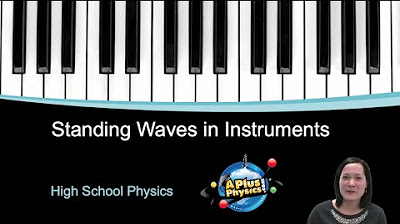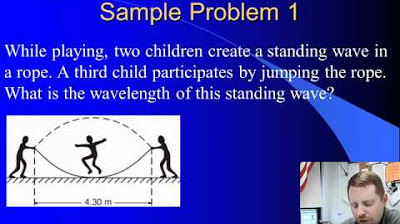A better description of resonance
TLDRIn this sponsored video by The Great Courses Plus, the creator revisits the concept of resonance, offering a more nuanced explanation than the common 'favorite frequency' analogy. Using a Rubens' tube, the video demonstrates how resonance amplifies specific frequencies by timing energy input correctly. The tube's resonant frequencies are visually represented through flames, illustrating standing waves with nodes and antinodes. The video connects this principle to sound production in wind instruments, explaining how resonant frequencies determine pitch and contribute to an instrument's timbre. It concludes with a recommendation for a course on wave dynamics and resonance.
Takeaways
- 🎶 The video introduces a 'Better Description of Resonance' series, aiming to explain the concept more effectively than the standard explanation.
- 🥂 The standard description of resonance is likened to an object's favorite vibration frequency, such as a wineglass or a guitar string.
- 📊 Resonance is better illustrated using a Rubens' tube, which demonstrates how energy builds up when the timing and frequency of taps are just right.
- 🔊 The Rubens' tube experiment shows that resonance occurs when energy input matches the natural frequency of the system, causing the amplitude to increase.
- 🔥 The video uses a Rubens' tube set on fire to visually demonstrate standing waves, with nodes and antinodes represented by the height of the flames.
- 🎵 Resonance in musical instruments, like blowing over a bottle, is explained by the amplification of resonant frequencies within the body of air.
- 🎸 The lowest resonant frequency is perceived as the pitch of the sound, while other frequencies contribute to the timbre, helping distinguish different instruments.
- 📚 The video mentions that the physics of a plucked guitar string is more complex and may be covered in a future video.
- 👨🏫 The Great Courses Plus is promoted as a resource for learning more about wave dynamics, resonance, and sound.
- 🔗 The video is sponsored by The Great Courses Plus, and viewers are encouraged to sign up for a free trial to access courses like 'Physics and Our Universe'.
- 📺 The video concludes with a demonstration of the Rubens' tube responding to music, showcasing the visual effect of resonance.
Q & A
What is the standard description of resonance mentioned in the video?
-The standard description of resonance is that when you ping a wineglass or pluck a guitar string, the note you hear is the frequency that the object likes to vibrate at, which is its resonant frequency.
What is a Rubens' tube and how is it used to explain resonance?
-A Rubens' tube is a hollow aluminum tube with one end blocked off with wood and the other with a rubber membrane. It's used to demonstrate resonance by tapping the membrane to send a pulse of pressure through the tube, which reflects back and forth, growing in size when the taps are timed correctly.
How does the size of the pulse in a Rubens' tube change when the taps are timed correctly?
-When the taps are timed correctly, the pulse of pressure in the tube gets larger with each tap because the energy from the new tap adds to the energy already in the system, creating a larger pulse.
What is the resonant frequency of the column of air inside the Rubens' tube?
-The resonant frequency of the column of air inside the Rubens' tube is the frequency at which the taps on the rubber membrane need to occur to maximize the energy in the system, resulting in the largest pulses.
How many resonant frequencies does a column of air in a Rubens' tube have?
-A column of air in a Rubens' tube has infinitely many resonant frequencies, corresponding to the different patterns of pulses bouncing back and forth within the tube.
What is a standing wave and how is it related to resonance?
-A standing wave is a wave pattern formed when two waves traveling in opposite directions cross over each other and add together. In the context of resonance, standing waves are created when the timing of energy input (like taps on a membrane) is such that the energy adds up at certain points (antinodes) and cancels out at others (nodes).
How does the video demonstrate the effect of resonance using a Rubens' tube filled with butane?
-The video demonstrates resonance by filling a Rubens' tube with butane and setting it on fire. The standing wave created by the resonant frequency causes variations in the flame height, with nodes showing smaller flames and antinodes showing taller flames.
What is white noise and how does it relate to resonance in wind instruments?
-White noise is a mixture of all frequencies within a range at the same time, often described as a hissing or whooshing sound. In wind instruments, blowing over the neck of an instrument like a bottle creates white noise, but only the resonant frequencies of the air body inside are amplified and heard, determining the perceived note.
How does the lowest resonating frequency of a wind instrument affect the sound produced?
-The lowest resonating frequency of a wind instrument is perceived as the pitch of the sound produced. The other frequencies generated contribute to the timbre of the sound, enriching its quality without changing the perceived pitch.
What is the relationship between the resonant frequencies and the timbre of a sound?
-The timbre of a sound is affected by the balance of resonant frequencies being generated. Different instruments have unique combinations of resonant frequencies, which help distinguish one instrument's sound from another.
How does the video suggest further exploration of resonance and related concepts?
-The video suggests taking an online course called 'Physics and Our Universe' available at thegreatcoursesplus.com for a more in-depth understanding of wave dynamics, resonance, and sound.
Outlines
🎵 Understanding Resonance with Rubens' Tube
This paragraph introduces the concept of resonance through the use of a Rubens' tube, a hollow aluminum tube with a rubber membrane at one end. The speaker taps the membrane to create pressure pulses that travel and reflect within the tube, demonstrating how resonance occurs when the timing and frequency of the taps are correct, causing the pulses to grow in amplitude. The paragraph also explains the existence of multiple resonant frequencies and the formation of standing waves with nodes and antinodes. To visually represent these concepts, a speaker is attached to the tube to drive the air at the resonant frequency, resulting in an increase in sound amplitude.
🔥 Visualizing Resonance with a Flaming Rubens' Tube
The second paragraph delves into visualizing resonance by setting a Rubens' tube on fire. The speaker replaces the finger tapping to drive the tube at its resonant frequency, and butane is pumped into the tube to create a flame. The flame's height at different points along the tube indicates the presence of nodes and antinodes, showing the pressure variations due to the standing wave. The paragraph then connects this demonstration to the resonance in wind instruments, explaining how only resonant frequencies are amplified when air is driven through the instrument, affecting the sound's timbre but not the perceived pitch.
🎓 Sponsorship and Further Exploration of Resonance
The final paragraph acknowledges the sponsorship of The Great Courses Plus and invites viewers to explore an online course called 'Physics and Our Universe' for a deeper understanding of wave dynamics, resonance, and sound. The speaker encourages viewers to sign up for a free trial on thegreatcoursesplus.com and mentions that using the provided link supports the channel. The paragraph concludes with a reminder to subscribe and turn on notifications for future videos, and suggests watching other videos related to resonance and entropy.
Mindmap
Keywords
💡Entropy
💡Resonance
💡Rubens' Tube
💡Resonant Frequency
💡Standing Wave
💡Nodes and Antinodes
💡White Noise
💡Timbre
💡Fourier Analysis
💡The Great Courses Plus
Highlights
Introduction of a series aiming to provide better descriptions of scientific concepts, starting with a better description of resonance.
Traditional explanation of resonance as the frequency an object likes to vibrate at, known as the resonant frequency.
Introduction of a Rubens' tube as a tool to illustrate the concept of resonance more effectively.
Description of the Rubens' tube construction and how it functions to demonstrate resonance through pressure pulses.
The process of tapping the rubber membrane to create and amplify pressure pulses within the tube, illustrating resonance.
Explanation of how resonance occurs when the timing and frequency of energy input align with the system's natural frequency.
Revealing that there are infinitely many resonant frequencies for a column of air, not just one.
Demonstration of standing waves created by overlapping pulses within the tube, resulting in nodes and antinodes.
The need for a faster method than finger tapping to visualize resonance, leading to the use of a speaker.
Using a speaker to drive the tube at its resonant frequency, causing an increase in sound amplitude.
The challenge of visualizing resonance in the air due to its invisibility, leading to the use of fire in the Rubens' tube.
Safety precautions and the process of setting up the Rubens' tube with butane for a visual demonstration.
Visual representation of nodes and antinodes in the flames of the Rubens' tube, showing the standing wave.
Connecting the concept of resonance to the sound produced by wind instruments and the role of resonant frequencies.
Explanation of how white noise is used to drive a range of frequencies in wind instruments, with only resonant frequencies being amplified.
The role of resonant frequencies in determining the perceived pitch and timbre of wind instruments.
A teaser for a future video on the complexities of resonance in guitar strings, involving Fourier analysis.
Promotion of an online course, 'Physics and Our Universe', sponsored by The Great Courses Plus, for further learning on wave dynamics and resonance.
Invitation to subscribe and enable notifications for future videos on the channel.
Transcripts
5.0 / 5 (0 votes)
Thanks for rating:





